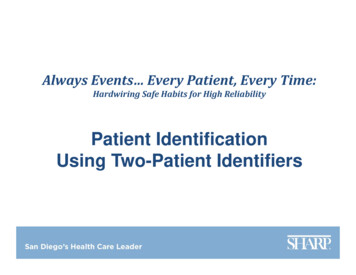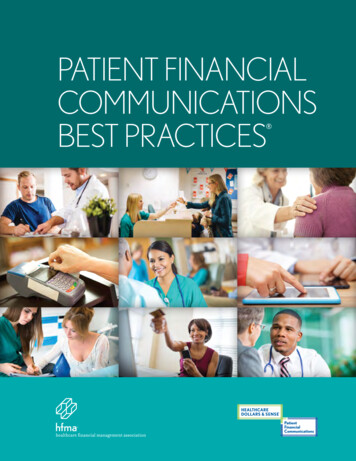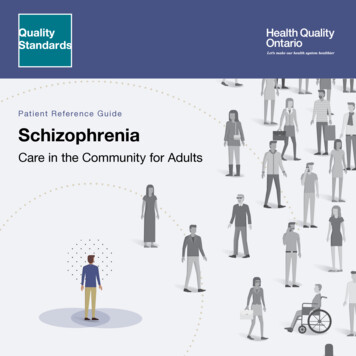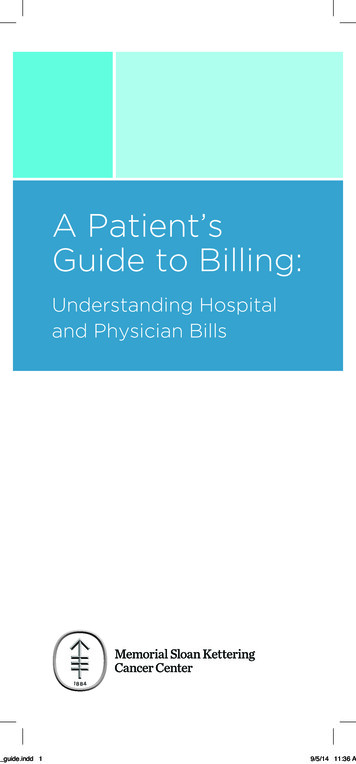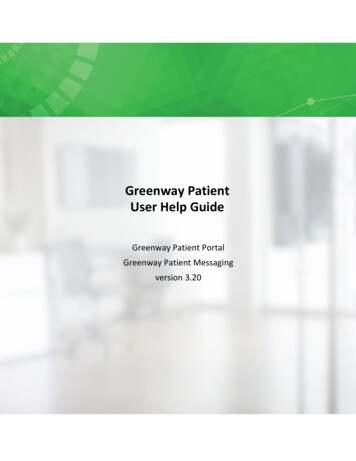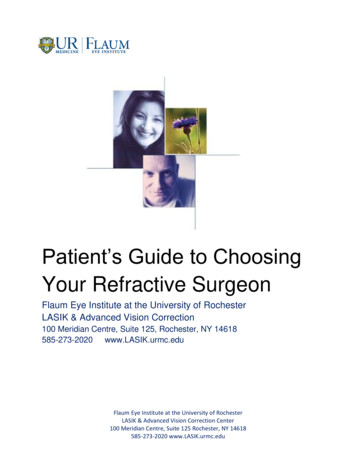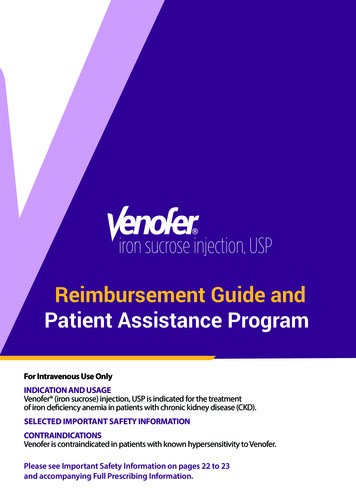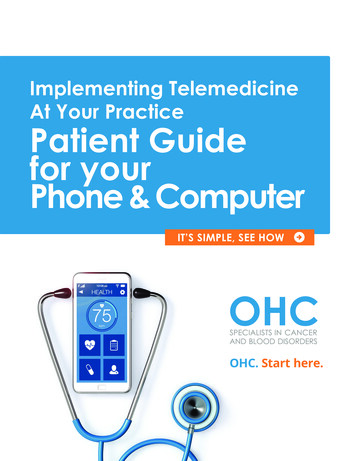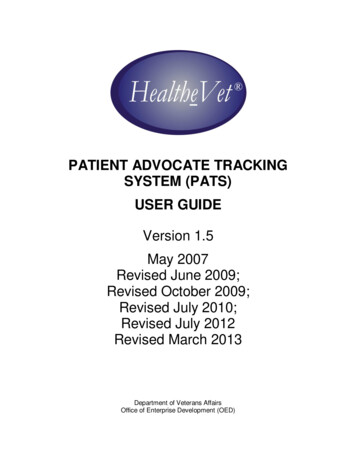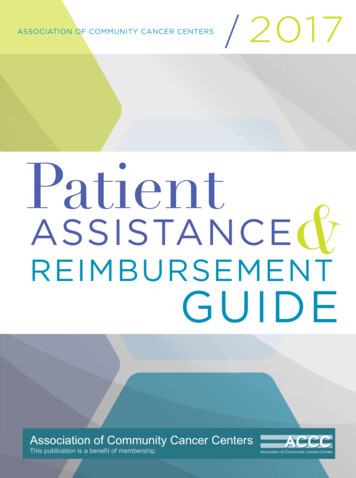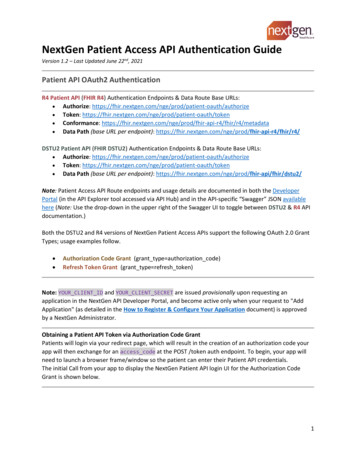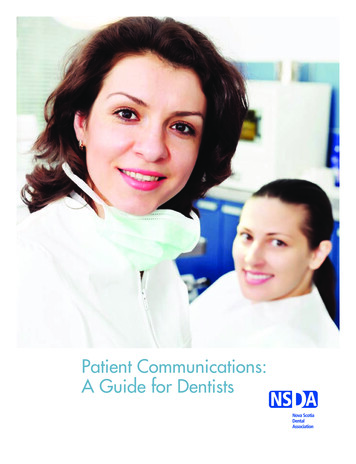
Transcription
Patient Communications:A Guide for Dentists
Your guideto better patientcommunicationThis guide outlines some simple strategies and tips forimproving communication with your patients.Research indicates that ‘soft skills’ have a direct bearingon patient perceptions of the value of care provided,the degree of trust placed in the dentist and the successof treatment.Although you may be familiar with some of thecommunication strategies included in this guide, reviewingthem may strengthen communication with your patientsand remind you to be as consistent as possible.
The goal of effective communication is simple:To empower your patients with the knowledge required to makean informed decision about their oral health. It is up to you tocommunicate your goals and expert opinions about your patients’oral health so that you and your patient can determine the besttreatment option.
Why goodpatientcommunicationis important
If you include your patients as fully informed partnersin their care, they’ll return the gesture by being loyaland continuing care with you. As an added bonus,you’ll discover more satisfaction in your work, renewedmotivation and increased productivity.3Considering patients will judge you by the way you interact with them, it is vital that you understandyour own communication style and adjust to meet the needs of various patients. When patients havea positive experience in your practice they will be more inclined to accept a recommended treatmentand return for ongoing care. They may also refer friends and family. This will help build your reputationand practice as well as enhance the image of the profession overall.123Increased patient satisfactionMedical evidence has demonstrated a positive associationbetween a patient’s satisfaction with the care they receiveand their provider’s ability and willingness to communicateand empathize with them.Reduced complaintsOpen dialogue with patients results in better patient retentionand a reduction in complaints. It is estimated that 4 out of 5calls from the public to the NSDA would have been resolvedthrough better communication between the dentist and patient.Improved efficiencyImproved communication with your patients will make yourpractice more efficient. For example, giving patients timeto express their concerns doesn’t take any longer but cansignificantly reduce the likelihood of late-arising concernsor missed opportunities to gather important data.Why good patient communication is important 3
Communicatingwith careThe dentist-patient relationshipThe first law of patient care is:Patient Satisfaction Perception – ExpectationsIf your patient perceives care at a certain level butexpected something more or different, then they will bedissatisfied. Both perception and expectation are statesof mind and you need to consider these if you want tokeep your patients happy.
Communicating with careIn its most basic form, good patient care consists of listeningto, understanding and responding to your patients’ needs.6While your oral health knowledge and clinical skills may beexceptional, few of us are taught the ‘soft skills’ of patientcommunication.While there are a multitude of patient needs –six basic needs stand out:12 EmpathyFriendlinessBasic courtesy and politeness; being warm and caring.The patient needs to know that the dentist appreciates theirwants and circumstances and provides personal attention.3 Efficiency and punctuality4 Control5 Options and alternativesInformation6The patient wants to feel they are respected.The patient wants to feel that they are an important partof their own treatment plan.The patient wants to know what treatment options areavailable; explaining options thoroughly.The patient wants to know about fees and services but in apertinent and time-sensitive manner.Communicating with care 5
The fundamentalsof patient relations
Patients want to be treated as individuals, not numbers.Here are a few rules of thumb for patient relations,which you and your staff should be mindful of: The patient is never an interruption to your work – the patient is your work. Everything else can wait. Even if you are delegating a task to a member of your staff, a casual “How are you feeling”gesture while your colleague does the work will comfort your patient. Never argue with a patient. The patient is always right (in their own eyes). Be a good listener,agree with your patient where you can, and do what you can to make them happy. Never make the first point of contact with your patient about finances. Too often the first questionasked is “Do you have insurance?” Discuss money matters at the appropriate time – only aftertreatment options have been determined and fully explained to the patient.Portrait of the ‘ideal’ Confidentdentist from the The dentist’s confidence gives me confidence.patient’s perspective: EmpatheticThe dentist tries to understand what I am feeling and experiencing, and communicates that understanding to me.HumaneThe dentist is caring, compassionate and kind.PersonalThe dentist is interested in me, interacts with me, andremembers me as an individual.FrankThe dentist tells me what I need to know in plain languageand in a forthright manner.RespectfulThe dentist takes my input seriously and works with me.ThoroughThe dentist is conscientious and persistent.The fundamentals of patient relations 7
Touchpointsof patientcommunication
1There are five key moments of interaction with yourpatients during their visit to your clinic. Each componentcan influence your patients’ overall experience and theirlevel of satisfaction.1The initial contactThe initial clinical encounter sets the tone for all other interactions throughout the visit. It may alsobe your best opportunity to avoid future misunderstandings or mismatched expectations betweenyou and your patient.Get the patient encounter off to a good start.As we know, first impressions matter. Try to spend a few moments to slow down and focus yourattention on meeting your patient’s needs. Be the first to greet your patient in the operatory – even if they are having hygiene work done first. Explain what will happen during their visit and introduce them to staff members who will beproviding care. Greet every patient with a friendly smile. Call patients by name. Introduce any colleagues who may accompany you. Sit at eye level. Listen attentively to their concerns. Don’t use technical jargon or terms that convey value judgments. Ask permission to examine the patient. Take the leadership role and guide the patient through the appointment.Touchpoints of patient communication 9
223The dental examinationThe dental examination is one of the most important, under-appreciated or even mis-understood componentsof the dental visit. For most this is a routine procedure, but for many patients it is perhaps the highlight oftheir visit and the only point at which they will have to interact directly with you. It is an opportunity toeducate your patients as to what is involved in the examination process.Most patients have no idea what the dentist does or what the dentist is looking for during the dental exam.An open discussion with your patient will help them better understand the value of what you do andenhance the relationship you have with them. Point out that you are checking things such as gum condition, overall health and function of the jaw,soft tissue condition, teeth spacing and bite, and so on. Explain what you are looking for as you proceed through the examination and provide the patient witha summary of your findings when you are finished. Encourage patients to ask questions so that they feel they are an active member of the oral health team. Consider an exam as an opportunity to provide ‘play-by-play’ information to your patient.3Discussing treatment optionsIn order for your patients to feel like true partners in their oral health care, they must be fully informedof the treatment options available to them. Be thorough in your explanation of treatment options sothe patient understands the pros and cons of each. This is an opportunity to demonstrate your clinicalexpertise and to build trust in your abilities and motivations.Use plain language to describe the recommended courses of treatment; avoid using jargonas much as possible: Lay out the options in a logical manner. For example, from the least complex (and costly)procedure to the most complex. Explain the reasons that account for each option. When possible, provide simple printed materials for the patient to take home. Avoid being judgmental about the patient’s choice of treatment. Ensure that all instructions for any treatment are as detailed and specific as possible. Check that you have been understood. Ask the patient if they have any questions andcorrect any misunderstandings as necessary.INFORMED CONSENTIn the context of a dental office, informed consent is “permission obtained as a resultof the process of information sharing in ongoing dialogue between the dentist andpatient”. No treatment should be performed without the express or implied consentof the patient. The onus is on you, the health care provider, to ensure that whateverdecision a patient makes, to accept or decline treatment, it must be informed.Consent must be obtained in advance of treatment – not in the middle and notafter the fact. Remember to document consent decisions in the patient chart.10 Touchpoints of patient communication
434Discussing fees and insuranceLet’s face it – discussing fees with your patients is rarely comfortable. But if you deal with the cost issuewith honesty and openness you can avoid misunderstandings and dissatifsation after the fact.Many patients are embarrassed to ask about fees, so it’s important that you take the lead.Dispelling misconceptionsCalls to the NSDA and public research show some basic trends in patient frustration around fees.Generally patients are unclear as to why “the same procedure” provided by different dentists isn’tbilled at the same cost. Some believe they are charged differently depending on whether they havedental insurance or not. Others only question the bill after they leave the practice because theywere too intimidated to approach the dentist.Although the NSDA’s Suggested Fee Guide is a tool for practitioners and a reference for outside groupssuch as insurers, patients see the Suggested Fee Guide as a “price list” and are frustrated when theircost of care varies from the Guide.Transparency in the numbersPatients want to have the money discussion with their dentist before discussing money withthe front desk staff. You should be prepared to have it.While it isn’t expected that you would know the details of all plans, you should be able to speak towhy you are charging a particular patient for a specific treatment. Follow up discussions with yourstaff will be more effective for the patient if they have the benefit of the information and context youprovide up front.Your patients need to know that fees are determined on the basis of many factors; factors that areconstant regardless of your patient’s insured status. These factors can include the time it takes toperform the procedure, the cost of materials and lab work, responsibilities related to scientific knowledge necessary to carry out the procedure and practice-related costs such as overhead and staffing.When talking about the fee for service with your patient: Initiate the fee conversation as patients often feel intimated to do so. Be specific about all the factors involved that determine the final fee. Approach the conversation with frankness and look for spoken and unspoken concernscoming from the patient. Discuss payment options which allow the patient to be in a position to make the optimaltreatment decision. Always hold the discussion with the patient sitting upright in the chair. Avoid shifting the discussion to other staff before your patient is ready to do so.Touchpointsofofpatientpatient communicationcommunication 1111Touchpoints
5Concluding the visit5The last few minutes of the patient consultation are just as important as the first.Ask your patient if they understand the treatment options discussed or have any questions. Look at your patient when speaking to them and avoid turning your back while anyone is speaking to you. Don’t conclude your final conversation en route to the door or when walking away. Confirm your patient’s treatment plan or follow-up. End the consultation with a reinforcing-type of physical contact. When appropriate, personally escort yourpatient to the reception area. At a minimum, use your patient’s name at the beginning and at the end of the interaction. Watch for those last minute questions people have as they leave the operatory. See a sign of hesitations asyour opportunity to ask “Do you have any other questions or concerns?” Do say “Call me if you think of anything else.” This gives the patient permission to reach out.12 Touchpoints of patient communication
5Rating your communications skillsIt’s easy to assume the way you currently communicatewith your patients is working. Recent Canadian DentalAssociation research conducted with dentists and patientsacross the country points out some gaps in understanding.Dentists said patient relationships are the mostimportant factor in building trust and that trust is built ontransparency, openness and communication.Patients said they felt dentist feedback was like “beingscolded” and that dentists provide inconsistent information,are unclear about what they are doing – especially duringan oral exam – and shift fee and other conversations totheir staff.The quality of the conversation is as important as the content. So asking about your patient’s hobbies,family and work is a great start. Speaking about the clinical, financial and health considerations thatare top of mind to your patient is equally, if not more, relevant in building rapport.Self assessmentAlwaysSometimesNeverDo you take the time to explain the agenda for each patient’s visit?Do you feel rushed within each appointment?During the dental exam do you explain what you’re seeing and looking for?When an exam is over, do you ask the patient if they have any questions?Do you discuss the pros and cons of treatment options?Have you expressed, as the expert, your preferred option of treatment?Do you supply patients with information they can take home with them?Do you take the time to discuss fees for treatment directly with your patient?Do you inform the patient of payment options?If this quick check has you intrigued, try the full set of interactive self assessment tools on the PatientCommunications section on the CDA website. Go to http://www.cda-adc.ca. Choose the “Members” section and log in with your CDA username and password. Click on Patient Communications.Rating your communications skills 13
Making timeto listen
You are the expert on clinical dentistry, but your patientsare the experts on their own decisions and how they impactthem. You are expected to express expert opinions basedon clinical findings and their implications.While you will always know more than your patients aboutdental diseases and problems, you place youself on precariousground when you imply that you know better than yourpatients about how dental care should fit into their lives.When you do so, you cross a boundary; your clinical opinionwill have less impact than it might have otherwise.The road to understanding begins with genuine interest. Curiosity is one of the communicationskills you must master if you want to create functional relationships with your patients.Listening and learning come before telling and educatingIn many practices, the emphasis is on telling rather than on listening to the patient. Become interestedand curious. Ask. Listen. Ask some more. Listen some more. Understand. Respect. Then, tell. Thisprocess puts significant emphasis on understanding our patients before the examination begins.Counselling techniques are invaluable in gaining an understanding of your patient and helping themadopt new behaviours that are important to promoting good oral health. By first trying to understandyour patient’s perspective you encourage him or her to develop a sense of competence and autonomy.Rather than telling patients what to do or what is right for them, you can help them find their own wayto make needed changes or adopt new behaviours.Practice listening skillsMany don’t realize the most critical and powerful aspect of communication is not speaking,but listening. Listening shapes speaking. By listening and really understanding the thoughts andconcerns of your patient, you generate a powerful relationship with them. If your patient feels youhave been an attentive listener they will be comforted, reassured and more likely to leave with apositive impression.14 Making time to listenMaking time to listen 15
The power of apologyMistakes happen to all of us. If you have erred, say so.Thoughtless or misconstrued comments by you, staff or thepatient can be harmful and escalate a situation. Defensivenessand blame intensify emotions and make resolution difficult –even when the issue is small.Small issues can grow into larger ones, if not addressedimmediately with openness and sincerity.The implementation of the Apology Act in Nova Scotia in 2008 may make professionals feel morecomfortable about providing apologies in order to help resolve disputes. In the Act, an apologymeans “an expression of sympathy or regret, a statement that one is sorry or any other words oractions indicating contrition or commiseration, whether or not the words or actions admit or implyan admission of fault in connection with the matter to which the words or actions relate.”The Act further says an apology: does not constitute an implied or expressed admission of fault or liability by the personin connection with the matter does not constitute a confirmation of cause of action or acknowledgement of a claim does not void, impair or otherwise affect any insurance coverage that is or,but for the apology, would be available may not be taken into account in any determination of fault or liability in connectionwith the matterTo read the entire Act, visit http://nslegislature.ca/legc/bills/60th 2nd/3rd read/b233.htm16 The power of apologyThe power of apology15
Dealing with difficult patient situations8Learn to see each problem as an opportunity for improvement.Here are some steps in dealing with patients:12345678Avoid downplaying the seriousness of the patient’s complaint.Let the patient tell you their side of the story withoutinterruption. Sometimes all they need is to be heard.Express empathy. Let patients know that you understandthe problem and are concerned about their feelings.Patients need to hear that you are on their side and arewilling to do whatever it takes to solve their problem.Do not go on the defensive. You are certain to lose the patientif you become confrontational.Take control of the situation. Once you have heard thepatient’s side of the story, take the appropriate action toresolve the problem.Ask the patient what they want. You may be surprised to findthat the patient’s solution to the problem is both fair and simple.Once you have established a plan of action, sell it.Explain to your patient how the plan will solve the problem.Ensure that the plan has been carried out and the resultsare acceptable to your patient – follow-up to ensure yourpatient is happy with the way you have handled the problem.By following these simple steps, a disgruntled patient canbecome your most valuable patient.Experience shows that a dissatisfied patient will sharetheir story with more people than will a satisfied patient.Dealing with difficult patients17
Adopting a team approachIt’s not enough to improve your own communication skills– you must engage your staff as well. Remember that yourteam members are representatives of your practice –they are the ones your patients turn to for informationregarding appointments, referrals, billing and lab tests.Great teams are created. A true team works well together and does not come apart at theseams when the workday becomes challenging. You should look at your staff and evaluate eachindividual’s commitment to effective communication with patients and other members of the team.Hold effective staff meetings: Schedule a meetingwhere staff can respond thoughtfully to a number ofquestions. The answers will be the first step towardcollaboration and improved communication withinthe office and with patients: Do you think the team communicates clearly?Consistently? Often enough? In what areas can the team improve communication? Are there practice/patient communication processesthat could be improved? What would be the single most important step weas a team could take to improve communicationwith patients?These questions should be openly discussed as ateam. After this meeting, let team members knowhow their responses will be used to benefit everyonein the practice.18 Adopting a team approachSet goals: Use the information you gathered to setgoals for improvement. Share these goals with theteam. They will appreciate that you listened to theirfeedback and, as a result, will be more acceptingof the positive changes you wish to make.Implement systems: It’s time to take the goals that havebeen set and create effective ways to accomplish them.With step-by-step systems in place, including ones forpatient communication, your practice will easily build astrong team. From scheduling to tray setup, it isimportant for the team to know exactly what to do,what to say and how to say it.Train the team: Training and cross-training areimportant ingredients for ensuring all members ofyour team are communicating effectively. Training alsoestablishes a level of accountability for communicationwhen combined with job descriptions for each team position.
Measuring patient satisfactionSatisfied patients become loyal patients and are morelikely to refer friends and family. Patient satisfaction surveysare an easy tool you can use as they can help you identifyways of improving your practice – which translates intobetter care, happy patients and happier staff.It’s important to move beyond ‘gut feel’ and systematically measure and monitor how your patientsfeel about their experiences so that you and your team receive honest feedback. This informationcan help boost morale, as well as engage the team on areas for continuous improvement.Monitoring patient satisfaction over time will enable your practice to celebrate improvementsand nip unwanted trends in the bud.It’s easy to carry out patient satisfaction surveys – it can be as simple as asking your patients tofill out a form. Most patients are happy to provide feedback – after all, their input allows you toimprove the service you offer them.Survey tools: You don’t need to go to an outsideconsultant to create and conduct a survey in youroffice. You can conduct an informal verbal surveyby asking each patient about their experience at theconclusion of their visit – take a second to ask andtake a minute to listen. Keep track of the issues andencourage your staff to do the same.Another technique involves the use of a simple form.Carefully craft five or six multiple choice questions,provide a consistent 1 to 5 rating scale (from poorto excellent) pre-printed on a single piece of paper.Include at least one open-ended question with space20 Measuring patient satisfactionfor written comments. Patients can complete the format the conclusion of their visit. You can also considerusing an online survey tool such as www.surveymonkey.comthat is free. An online tool gives the patient a sense ofprivacy, away from the practice, to consider theirexperience and provide constructive feedback.Keeping score: Review what you find with your staffat least monthly. Take pride in areas of strength andwork on raising the score over the following month.The measures of your efforts will include increasedpatient satisfaction, stronger patient retention andmore patient referrals.
Original development and design courtesy the Alberta Dental Association CollegeNSDA-related content and further changes were made to the original designPrinting by Advocate Printing
www.nsdental.org1559 Brunswick Street, Suite 101Halifax, NS B3J 2G1Phone: (902) 420-0088
improving communication with your patients. Research indicates that ‘soft skills’ have a direct bearing on patient perceptions of the value of care provided, the degree of trust placed in the dentist and the success of treatment. Although you may be familiar with some of the c

